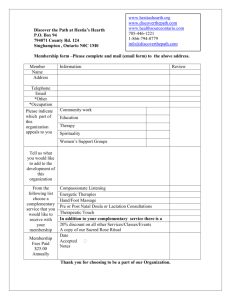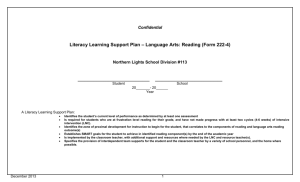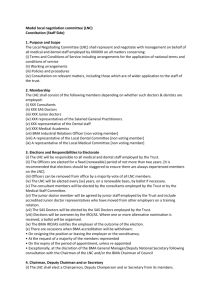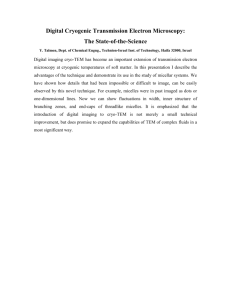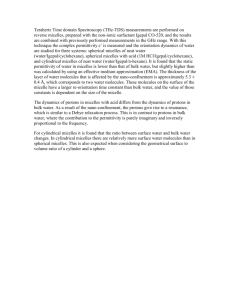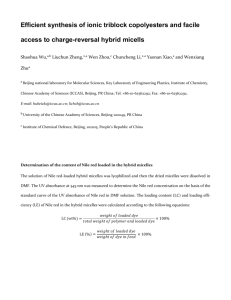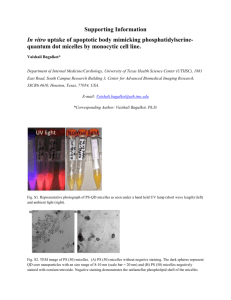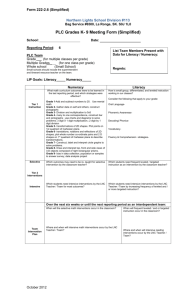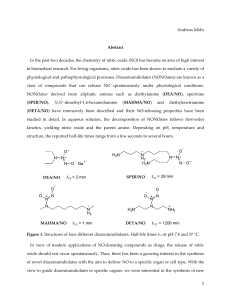BIODEGRADATION AND BRAIN TISSUE REACTION - HAL
advertisement
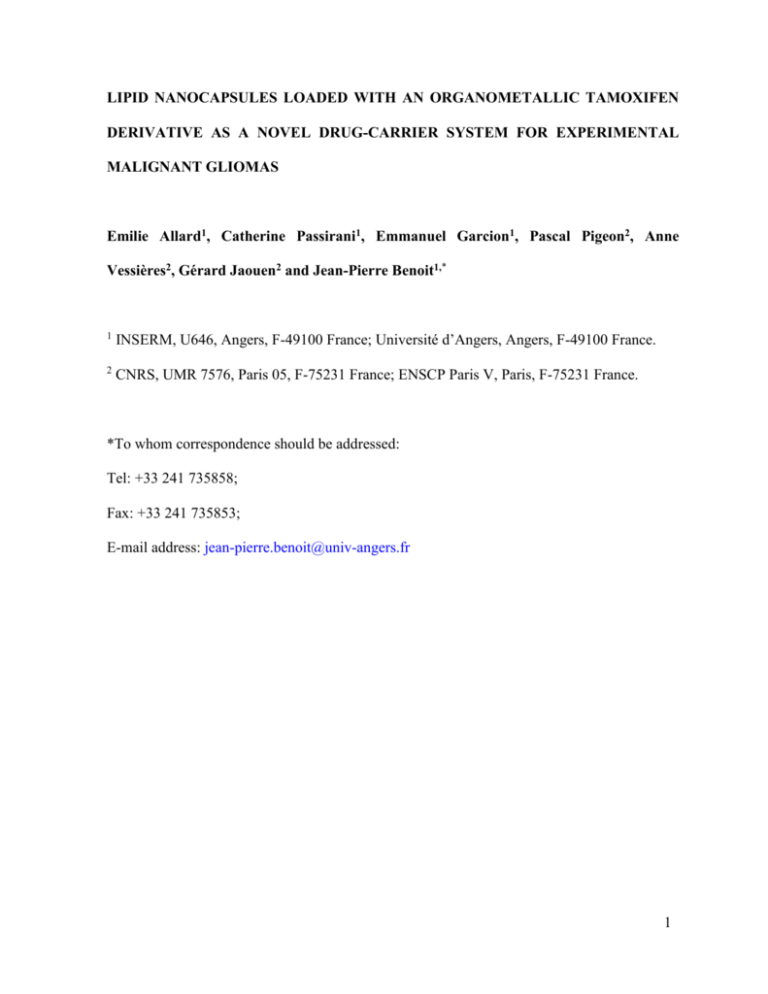
LIPID NANOCAPSULES LOADED WITH AN ORGANOMETALLIC TAMOXIFEN DERIVATIVE AS A NOVEL DRUG-CARRIER SYSTEM FOR EXPERIMENTAL MALIGNANT GLIOMAS Emilie Allard1, Catherine Passirani1, Emmanuel Garcion1, Pascal Pigeon2, Anne Vessières2, Gérard Jaouen2 and Jean-Pierre Benoit1,* 1 INSERM, U646, Angers, F-49100 France; Université d’Angers, Angers, F-49100 France. 2 CNRS, UMR 7576, Paris 05, F-75231 France; ENSCP Paris V, Paris, F-75231 France. *To whom correspondence should be addressed: Tel: +33 241 735858; Fax: +33 241 735853; E-mail address: jean-pierre.benoit@univ-angers.fr 1 ABSTRACT Ferrocenyl diphenol tamoxifen derivative (Fc-diOH) is one of the most active molecules of a new class of organometallic drugs, showing in vitro antiproliferative effects on both hormonedependent and independent breast cancer cells. For the first time, Fc-diOH was tested on a 9L glioma model according to two encapsulation strategies: lipid nanocapsules (LNC) and swollen micelles. LNC showed a higher drug loading capacity because of a larger oily core in their structure and were able to be up taken by glioma cells. The large amount of PEG present at the micellar interface prevented interaction with cytoplasm membrane which led to a low level of micelle cell uptake and no biological activity. On the contrary, Fc-diOH cytostatic activity was conserved after its encapsulation in LNC and was very effective on 9L-glioma cells as the IC50 was about 0.6µM. Interestingly, Fc-diOH-loaded LNC showed low toxicity levels when in contact with healthy cells, conferring a functional specificity of this compound on tumour cells. Finally, Fc-diOH LNC treatment was able to lower significantly both tumour mass and volume evolution after 9L-cell implantation into rats which evidenced for the first time the in vivo efficacy of this new kind of organometallic compound. Keywords: Lipid nanocarrier, organometallic compound, cell uptake, drug delivery, 9L tumour model 2 1. INTRODUCTION Gliomas are the most common type of primary brain tumours. The prognosis for patients with glioblastoma, the most aggressive type of brain malignancy, has remained largely unchanged over the last three decades. Recent studies give a median survival time of 14.6 months for patients treated with radiotherapy plus temozolomide, which is the reference chemotherapy, and 12.1 months with radiotherapy alone [1]. Clearly, new and effective therapies are desperately awaited. Tamoxifen, a member of the Selective Estrogen Receptor Modulator (SERM) family, has been widely used in the treatment of estrogen receptor (ER)-expressing breast cancer [2-4]. Because antitumour effects have been predominantly observed in patients with ER-positive tumours, it is generally accepted that the primary action of hydroxytamoxifen, its active metabolite, is mediated through inhibition of the ER pathway. But, it has previously been shown that some ER-negative cancers also respond to tamoxifen, [5, 6] which means that the molecule can be active because of an ER-independent antitumour mechanism that has not yet been clearly identified [7]. Taking into account that gliomas are ER-negative [8-10], the moderate beneficial effect of tamoxifen in glial neoplasms has been linked to an ER-independent antitumour mechanism. For the treatment of patients with recurrent malignant gliomas, only trials using high-dose tamoxifen alone or in combination with other cytotoxic agents have demonstrated positive results [11-13]. As a consequence, SERM represent a promising therapy for gliomas if their antitumour activity can be improved. Previously, a potentially cytotoxic moiety, ferrocene, was incorporated into the tamoxifen skeleton [14]. A series of these molecules, called organometallic tamoxifen derivatives by analogy, were prepared and their cytotoxic effects were studied, initially on breast cell lines [15, 16]. By modifying various structural aspects of the ferrocenyl derivatives, one of the most 3 effective compounds to date in term of cytotoxicity is the ferrocenyl diphenol compound FcdiOH (Fig. 1). This compound showed high levels of in vitro antiproliferative activity against both hormone-dependent (MCF7, IC50 = 0.7μM) and independent (MDA-MB231, IC50 = 0.6μM) breast cancer cell lines [16], and has become the standard to which the activity of novel organometallic anti-cancer drugs can be compared. The observed antiproliferative effect of these molecules can be divided into two actions: anti-oestrogenic in ER(+) cells and cytotoxic in both ER(+) and ER(-) cells. The efficacy of these drugs has been related to an activation pathway which involves the in vitro oxidation of the ferrocene and phenol functions [17, 18]. These organometallic tamoxifen derivatives could have an enormous impact on medicine, in particular in the treatment of cancer [19]. As demonstrated by Rosenberg's discovery of cisplatin [20] which revolutionized the treatment of testicular cancer, organometallic complexes can be a powerful weapon as antitumour agents [21]. In the present study, the antitumoural efficacy of Fc-diOH was tested on glioma cells. As this product is very hydrophobic, and since its water-insolubility can impede its potential biological activity [22], we aimed at developing a new way to administer this molecule. Two strategies were investigated: a ferrocenyl diphenol compound was encapsulated in lipid nanocapsules (LNC) for one strategy and in swollen micelles for another, according to an organic solvent-free process recently developed in our laboratory [23]. These lipid nanocarriers obtained by a low-energy emulsification method were characterised by the absence of organic solvent in their formulation. They presented a low particle size, ranging from 10 to 20nm for swollen micelles and from 20 to 100nm for LNC, with a narrow polydispersity size and the capacity to carry lipophilic molecules. Taking into account these various advantages, Fc-diOH-loaded nanocarriers were developed and tested on glioma culture cells and on a subcutaneous 9L-rat glioma model. 4 2. MATERIALS AND METHODS 2.1. Materials Ferrocenyl diphenol compound (2-ferrocenyl-1,1-bis(4-hydroxyphenyl)-but-1-ene) named FcdiOH was prepared by McMurry coupling [24]. Its purity was assessed by HPLC, NMR and elemental analysis. Hydroxytamoxifen, Ferrocene and Nile Red were supplied by SigmaAldrich (Saint Quentin Fallavier, France). The lipophilic Labrafac CC (caprylic-capric acid triglycerides) was kindly provided by Gattefosse S.A. (Saint-Priest, France). Lipoïd S75-3 (soybean lecithin at 69% of phosphatidylcholine) and Solutol HS15 (a mixture of free polyethylene glycol 660 and polyethylene glycol 660 hydroxystearate) were a gift from Lipoïd Gmbh (Ludwigshafen, Germany) and BASF (Ludwigshafen, Germany), respectively. NaCl, acetone, ethanol and tetrahydrofurane (THF) were obtained from Prolabo (Fontenay-sousbois, France). Deionized water was obtained from a Milli-Q plus system (Millipore, Paris, France). 2.2. Preparation of Fc-diOH-loaded nanocarriers Lipid nanocarriers were prepared according to a previously described original process [23]. In order to obtain LNC, Solutol HS15 (17% w/w), Lipoid (1.5% w/w), Labrafac (20% w/w), NaCl (1.75% w/w) and water (59.75% w/w) were mixed and heated under magnetic stirring up to 85°C. Three cycles of progressive heating and cooling between 85 and 60°C were then carried out and followed by an irreversible shock induced by dilution with 2°C deionised water (45 or 70% v/v) added to the mixture at 70-75°C. To formulate Fc-diOH-loaded LNC, two parameters will be changed: the amount of Fc-diOH in triglycerides (1.7% and 4% (w/w)) 5 and the volume of cold water for LNC dilution (70% and 45% v/v) for drug loading of 1mg/g (0.84% w/w dry weight) and 6.5mg/g (2% w/w dry weight) respectively. To form swollen micelles, Solutol HS15 (64.25% w/w), Labrafac(5% w/w), NaCl (1.75% w/w) and water (29% w/w) were mixed and the same formulation flow chart was applied as previously described. To formulate Fc-diOH-loaded micelles 1mg/g (0.24% w/w dry weight), the amount of Fc-diOH in triglycerides was equivalent to 3.4% (w/w) and the volume of dilution was about 42% (v/v). Fluorescent lipid nanocarriers were obtained by using Nile Red, an hydrophobic fluorescent marker, previously dissolved in acetone at 2µg/µl. The resulting Nile Red solution was incorporated in the triglyceride phase at 50:50 (w/w) and the acetone was evaporated before use. Fluorescent LNC and micelles were then prepared as described above. 2.3. Characterisation of the nanocarriers 2.3.1. Particle size and zeta potential The nanocarriers were analysed for their size and charge distribution using a Malvern Zetasizer Nano Serie DTS 1060 (Malvern Instruments S.A., Worcestershire, UK). The nanocarriers were diluted 1:100 (v/v) in deionised water in order to assure a convenient scattered intensity on the detector. 2.3.2. LNC drug payload and encapsulation efficiency Because of the orange colour of the anticancer drug, the Fc-diOH payload was determined by spectrophotometry at 450nm after dissolving LNC and swollen micelles in solvent mixtures as described below. As the water solubility of Fc-diOH was inferior to 0.001µg/ml, if the product 6 was not entrapped in nanocarriers, drug precipitation occurred and the precipitate could be retained by a filter. Consequently, a part of the formulation of each batch was filtrated using a Minisart® 0.1-μm filter (Sartorius). Three samples of each batch of Fc-diOH-loaded nanocarriers (filtrated and non-filtrated) were prepared by dissolving 250mg of nanocarriers in 2.25ml of 22/67/11 (v/v/v) acetone/THF/water solution. Quantification was achieved by comparing the absorbency of ferrocenyl derivative samples to a calibration curve made with blank nanocarriers and Fc-diOH ethanol/THF/water solution. Mean drug payload (milligrams of drug per gram of LNC dispersion or micellar solution) and encapsulation efficiency (%) were calculated. 2.4. Cell experiments 2.4.1. Cell culture Rat 9L gliosarcoma cells were obtained from the European Collection of Cell Culture (Salisbury, UK, N°94110705). Purified newborn rat primary astrocytes were obtained by the mechanical dissociation method from cultures of cerebral cortex as originally described [25]. The cells were grown at 37°C/5% CO2 in Dulbecco modified Eagle medium (DMEM) with glucose and L-glutamine (BioWhittaker, Verviers, Belgium) containing 10% foetal calf serum (FCS) (BioWhittaker) and 1% antibiotic and antimycotic solution (Sigma, Saint-Quentin Fallavier, France). 2.4.2. Observation of nanocarrier internalisation by confocal images 9L cells were plated at 104/ml on 24-well plates covered with 14mm microscope cover glasses coated with a solution of 5µg/ml in PBS of poly-D-lysine hydrobromide mol wt 70,000150,000 (Sigma, Saint-Quentin Fallavier, France). After 48h of culture, the culture medium 7 was removed and changed to a serum-free medium containing 50% DMEM, 50% Ham’s F12 and N1 complement. At Day 3, the medium was totally removed and the cells were incubated for 2 hours with a medium containing the medium alone as a negative control, fluorescent LNC 1:1,000 or fluorescent micelles 1:1,000. The cells were then washed twice with Hanks balanced salt solution (HBSS, BioWhittaker) and fixed with 4% paraformaldehyde in PBS for 15 minutes at 4°C. They were washed three times with HBSS, the cover glasses were removed and finally mounted on slides in glycerol/PBS 1:1. The cells and fluorescent nanocarriers were observed by confocal microscopy (Olympus light microscope Fluoview FU 300 Laser Scanning Confocal Imaging System, Paris, France) with a helium-argon laser (λex: 543nm, λem: 572nm). The morphology of the 9L cells was shown by Nomarsky contrast. 2.4.3. Quantification of nanocarrier internalisation by flow cytometry A BD FACSCalibur fluorescent-activated flow cytometer and the BD CellQuest software (BD Biosciences, Le Pont de Claix, France) were used to perform flow cytometry analysis. Nile Red-loaded micelles (1/1,000) and Nile Red-loaded LNC (1/1,000) were incubated with 9L glioma cells in a serum-free medium containing 50% DMEM, 50% Ham’s F12 (Biowhittaker) and N1 complement (Sigma). After 2 hours of incubation, the removal of the attached nanocarriers was accomplished by washing the cells three times with HBSS. The cells were then detached by trypsinisation. After centrifugation, they were resuspended in a 0.4% (w/v) Trypan Blue solution in HBSS to quench the extracellular fluorescence, thus enabling the determination of the fraction that was actually internalised. The treated samples were subsequently washed twice, and analysed by flow cytometry in at least triplicate experiments, with 10,000 cells being measured in each sample. For quantification analysis, no treatment (9L cells) was considered to be the 100% of fluorescence intensity. 8 2.4.4. In vitro cell viability The cells were first plated at 104 cells/mL on 24-well plates for 48h in DMEM containing 10% FCS and 1% antibiotic/antimycotic and then treated with increasing concentrations of various preparations. To test the impact of the drug alone (non encapsulated) on cells, solvent like ethanol (for Fc-diOH and OH-Tam) and acetone (for Fc) were used to solubilise the drugs. Drug in solution were prepared at a concentration of 0.1 M and a dilution of 1:1,000 in culture medium was realised to obtain the higher concentration tested on cells (100µmol/L). To test drugs encapsulated in micelles or in LNC at this concentration, a dilution of 1: 23.5 was realised in culture medium. For the others concentrations, 1: 10 cascade dilution was performed. Blank LNC and micelles were tested as controls and with the same excipient concentration than that needed for Fc-diOH ones. The cells were incubated at 37°C/5% CO2 for 96h. Thereafter, cell viability was determined by the MTT test according to the procedure described by Mosmann [26]. Briefly, 40µl of MTT solution at 5mg/ml in PBS 1X were added to each well, and the plates were incubated at 37 °C for 4h. The medium was removed and 200µl of acid–isopropanol 0.06N was added to each well and mixed thoroughly to completely dissolve the dark blue crystals. The optical density values were measured at 580nm using a multiwell-scanning spectrophotometer (Multiskan Ascent, Labsystems SA, Cergy-pontoise, France). Two independent repetition experiments are conducted, each with a least 6 repeated samples. 2.5. Animal study 2.5.1. Animals and anaesthesia Syngeneic Fischer F344 female rats weighing 160-175g were obtained from Charles River Laboratories France (L’Arbresle, France). All experiments were performed on 10 to 11-week 9 old female Fisher rats. The animals were manipulated under isoflurane/oxygen anesthesia. Animal care was provided in strict accordance to French Ministry of Agriculture regulations. 2.5.2. Tumour and nanocarrier implantation A cultured tumour monolayer was detached with trypsin-ethylene diamine tetraacetic acid, washed twice with EMEM without FCS or antibiotics, counted, and resuspended to the final concentration desired. For tumour growth analysis, animals received subcutaneous injections (s.c) of 1.5 x106 9L cells into the right thigh. On Day 6 after cell injection, rats implanted with 9L cells were treated by an intratumoural (i.t) single injection (400µl) of different treatments. Group 1 was injected with physiological saline (control; n = 7 animals), Group 2 received blank LNC (n = 7 animals), Group 3 received Fc-diOH-loaded micelles 1mg/g (2.5 mg/kg; n = 8 animals), Group 4 received Fc-diOH-loaded LNC 1mg/g (2.5mg/kg; n = 8 animals) and Group 5 was treated with Fc-diOH-loaded LNC at a higher dose of 6.5mg/g (16.2 mg/kg; n = 5 animals). The length and width of each tumour were regularly measured using a digital caliper, and tumour volume was estimated with the mathematical ellipsoid formula given in equation (1). At the end of the study (Day 30), the rats were sacrificed and the weight of each tumour was evaluated. Volume (V) = (π/6) x width2 (l) x length (L) (1) 2.6. Statistical analysis For in vitro cell survival tests, statistics and analysis of the Similarity Factor f2 were employed to evidence significant curve profiles (f2 < 50 was considered to be significant). The statistical significance for the in vivo study was determined for each experiment between groups by a student t-test (P<0.05 was considered to be significant). 10 3. RESULTS AND DISCUSSION 3.1. Preparation and characterisation of Fc-diOH-loaded nanocarriers By mixing Fc-diOH with excipients at well-characterised concentrations described by a ternary diagram [23] and by applying the phase inversion process, lipid nanocapsules and swollen micelles loaded with Fc-diOH were obtained. LNC loaded with the anticancer drug presented a very narrow size between 44.7 and 51.7nm, depending on the drug payload, and were monodispersed (PI < 0.15) (Table 1). Fc-diOH-loaded LNC were also characterised in term of surface charge. Zeta potential values ranged from -10.0 to -11.5mV. The physicochemical properties were very similar to previously-studied standard blank LNC [27, 28]. Indeed, because of the presence of PEG dipoles in their shells, 50nm blank LNC have a low zeta potential of approximately –10mV [29]. The presence of the active drug did not affect the zeta potential value which means that the entrapment of Fc-diOH was very efficient. Due to the nearly negligible solubility of ferrocenyl compound in water and its high solubility in triglycerides (Labrafac®), it was possible to reach high drug loading levels, up to 6.5mg of Fc-diOH per gram of LNC suspension (2% w/w dry weight). Like many hydrophobic drugs [30-32], Fc-diOH was well-encapsulated in LNC with a high encapsulation efficiency above 98% (Table 2). Due to a low quantity of triglycerides present in swollen micelles and because of the limit of solubility for Fc-diOH in triglycerides, it was only possible to obtain micelles with a drug load equivalent to 1mg/g (0.24% w/w dry weight). Nevertheless, they were obtained with the same size and zeta potential as blank micelles (Table 1). The Fc-diOH-loaded micelles were characterised by a very small particle size, 13.2 ± 0.3nm, the same as for blank ones (13.0 ± 0.1nm) and exhibited a very weak negative charge with values around -2mV. The 11 incorporation of Fc-diOH in swollen micelles was very effective, as demonstrated by the high encapsulation efficiency and the stability of the zeta potential (Tables 1&2). 3.2. Cell line experiments 3.2.1. Nanocarrier cell uptake The internalisation of lipid nanocarriers in glioma cells was investigated by confocal microscopy and flow cytometry after the formulation of Nile Red (NR)-loaded LNC and micelles. As their size and charge measurements were very similar to those of blank nanocarriers (Table 1), NR-loaded LNC and micelles were considered to mimic the behaviour of nanocarriers entrapping the anticancer drug. Quantitative cellular uptake by FACS analysis (Fig. 2) and images taken after the incubation of fluorescent nanocarriers with 9L cells (Fig. 3) showed that there was a significant difference between the two nanocarriers in terms of cell uptake. Fig. 2A shows that LNC were rapidly taken up by 9L cells. Cell fluorescence intensity increased from 100% for cells alone (control) to 354.4% for cells incubated with NR-LNC (Fig. 2B). As seen in Fig. 3A, all the fluorescence was found inside the cell, while avoiding the nucleus, demonstrating an uptake of the nanocapsules. This uptake could be attributed to the interactions between 50nm LNC and cholesterol-rich microdomains as previously observed [33]. On the contrary, a very weak level of fluorescence was observed after the incubation of Nile Red-loaded micelles with 9L cells which means that only a few micelles are able to penetrate the cells (Fig. 3B). Cytometry results confirmed that fluorescent micelles were taken up by 9L cells at much lower levels than LNC (205.2%) (Fig. 2B). Dunn et al. investigated the effect of an increased surface density of PEG with constant chain length, on the uptake of pegylated nanoparticles by non-parenchymal liver cells. The interaction of the particles with cells was shown to decrease as the surface density of PEG increased [34]. The 12 surfactant barrier in swollen micelles was more than 7 times higher in proportion to those used for LNC formulations for the same drug load. So, whereas micelles are smaller than LNC, the presence of high density PEG coating certainly decreased interaction with cells and could be responsible of the low internalisation of swollen micelles in 9L glioma cells. Moreover, when the concentration of Solutol® HS15 was above its CMC (0.03% w/v), the amount of colchicine taken up into rat hepatocytes, as well as its uptake velocity, were significantly decreased [35]. This phenomenon was explained by an inhibition of colchicine transport either due to direct interaction at the transport site or due to alteration of membrane properties in the presence of Solutol® HS15 micelles. 3.2.2. Cell viability Fc-diOH was tested in vitro in a survival assay on 9L glioma cell and on newborn rat astrocyte primary cultures. Ferrocene (Fc) and hydroxytamoxifen (OH-Tam), which are the main molecules of the Fc-diOH structure, were also tested. No toxic effect was observed for the ethanol/acetone solutions used to solubilise drugs in solution (data not shown). Glioma cell culture studies revealed that a distinct and large decrease in cancer cell viability could be achieved with Fc-diOH, contrary to OH-Tam and Fc (Fig. 4A). The IC50 for Fc-diOH was about 0.5µM whereas OH-Tam was totally inactive at this concentration range (IC50 = 35µM). Similar results had already been found in MDA-MB231 cells which are classified as ER(-) breast cancer cell lines, since the IC50 for ferrocenyl tamoxifen derivative and OH-Tam were about 0.5µM [36] and 34µM respectively [37, 38]. Tamoxifen, the reference molecule of the SERM family, is well known to act through its inhibition of ER. However, it has been already described that the oxidation of tamoxifen to quinoids is a recognised pathway of cytotoxicity [39, 40]. As glioma cells are classified as ER(-) cell lines [9], the moderate effect of tamoxifen 13 on 9L cells can be attributed to its oxidant activity. Furthermore, ferrocene was totally inactive on 9L cells. The same result has already been observed on ER(+) and ER(-) breast cell lines [15], even though it showed some antitumour potential, though at high concentrations (10-4M), when oxidized into the ferrocenium ion [41]. The fact that Fc-diOH showed cytotoxic activity at much lower concentrations than OH-Tam suggests that the Fc group has a role in the observed cytotoxic effect. The easier oxidation of ferrocene in comparison to phenol, makes the oxidative metabolism of ferrocenyl derivatives easier, and consequently leads to better antiproliferative activity. As shown in Figure 4B, in astrocyte cells which are slow- or nondividing cells, Fc-diOH at equivalent doses to those added to glioma cells demonstrated a largely reduced level of cell toxicity (IC50 = 50µM) equivalent to OH-Tam, whereas ferrocene was characterised overall by a total absence of cytotoxicity. These results indicate that FcdiOH is toxic to brain tumour cells with a high potential for cell division, and harmless towards healthy cells. Cell survival curves were not significantly different between Fc-diOH in solution and FcdiOH-loaded LNC, showing that the activity of the drug was totally recovered in vitro after encapsulation (Fig. 4C). Moreover, Fc-diOH-loaded LNC demonstrated cytotoxic activity on 9L cells 150-fold higher than blank LNC. Taking into account the cytotoxic mechanism of ferrocenyl molecules proposed by Hillard et al. [17], these results suggest that LNC improved intracellular bioavailability of Fc-diOH. Indeed, it was demonstrated that upon electrochemical oxidation of the ferrocene group, a partial positive charge is imparted to the hydroxyl group of the molecule, thus acidifying the proton, which may then be easily abstracted by basic species like DNA, glutathione (GSH), or proteins, only present in the intracellular compartment. In a subsequent second oxidative step, quinone methide is formed, 14 and is activated for nucleophilic attack by sulphur and nitrogen donor groups from biomolecules which may lead to cell death. Furthermore, an advantageous effect was found for Fc-diOH when in contact with astrocytes (Fig. 4D). In fact, Fc-diOH in solution or entrapped in LNC, was found to be much less cytotoxic on astrocytes compared to cancer cells. The higher cytotoxic effect of Fc-diOH-loaded LNC in glioma cells than in astrocytes could be triggered by easier accessibility of the intracellular target during cell division. Additionally, astrocytes are considered to play an important role in the defence of the brain against reactive oxygen species (ROS) [42]. They are known to contain higher levels of various antioxidants, especially GSH, than other brain cell types like neurons and oligodendrocytes [43-45]. As GSH may be a potential target of the ferrocenyl tamoxifen derivatives, it can explain the reduced cell death of Fc-diOH on astrocytes. The higher cytotoxic effect of Fc-diOH-loaded LNC on glioma cells than on astrocytes cannot be explained by increased endocytosis during cell division, since LNC uptake is quantitatively equivalent in the two types of cells (A. Paillard et al., unpublished observation). Consequently, Fc-diOH can be considered as a cytostatic anticancer molecule from an in vitro concentration of 0.5-0.6µM. The results obtained with Fc-diOH-loaded micelles were different (Fig. 4E-F). Firstly, the activity of Fc-diOH in solution was not recovered after its encapsulation in swollen micelles. Moreover, there was no significant difference between blank and Fc-diOH-loaded micelles on 9L cell survival percentage, which means that the observed toxicity was related to the nanocarrier and not to the anticancer drug. The toxicity of swollen micelles was certainly due to the presence of excipients, especially surfactant molecules like Solutol®. In fact, the use of Solutol® HS15 in pharmaceutical preparations for in vitro applications should be considered 15 with care. Woodcock et al. studied the toxicity of different surfactants on cells and their capability to reverse multidrug resistance (MDR) [46]. Concerning Solutol® HS15, they concluded that 2/3 of the R100 cells (MDR-derivative of human leukaemia cell line) were lysed when incubated for only 1 hour with this polyethoxylated solubilising agent at concentrations equivalent to 1:100 (w/v) and 100% were lysed by 1:10 (w/v). Despite lower concentration of Solutol® HS15 in our micelles (0.037%), toxicity on 9L glioma cells was noted for blank micelles after 2 hours of incubation. In addition, swollen micelles were found to be toxic on healthy cells as well as on cancer cells as the IC50 was about 5µM on both cell types (Fig. 4F). The cytotoxic activity of Fc-diOH on 9L decreased dramatically when it was encapsulated in micelle which confirms that swollen micelles were poorly internalised in 9L cells. 3.3. In vivo study A 9L subcutaneous glioma model was used to evaluate the efficacy of Fc-diOH LNC and micelles. After tumours had developed to about 100mm3, we performed comparative efficacy studies by dividing animals into five groups according to the treatment they received. Rats were separated in random samples in a way to minimize weight and tumour size differences among the groups. Rats of the control and LNC groups were characterised by a very quick progression of tumour volume which reached 2,500 and 2,000mm3 by Day 30, respectively. (Fig. 5). On the contrary, Fc-diOH-loaded LNC significantly inhibited tumour growth (p < 0.05) which means that the cytostatic activity of Fc-diOH was preserved in vivo. Indeed, rats treated with a single injection of LNC at an equivalent dose of 2.5mg/kg presented tumours three times smaller (700mm3 at Day 30) than the ones treated by blank LNC (Fig. 5A). In contrast, rats treated by Fc-diOH-loaded micelles with the same anticancer drug dose had 16 tumours that grew very quickly and reached 1,600mm3 by the end of the study. These in vivo data can be linked to the conclusions made about nanocarrier uptake in 9L cells as an intratumoural treatment with Fc-diOH-loaded micelles was less effective than Fc-diOH-loaded LNC injection. Similarly, tumour growth assessed by tumour mass at the end of the study showed that the mean tumour mass had significantly decreased from 1.1 to 0.6g for 1mg/g loaded swollen micelles and LNC, respectively (Fig. 5B). Nevertheless, no dose effect was evidenced as rats treated with Fc-diOH-loaded LNC at an equivalent dose of 16.2 mg/kg (6.5mg/g load) had s.c. tumour growth similar to LNC ones at an equivalent dose of 2.5mg/kg (1 mg/g load). The systematic diminution of size observed for 6.5mg/g-loaded LNC (44.7nm as opposed to 51.3 or 51.7nm for 1mg/g and 0.5mg/g, respectively, see Table 1) could be due to an intramolecular association between Fc-diOH molecules at this concentration which could explain the absence of dose effect. Moreover, a loss of Fc-diOH oxidative activity during the solubilising step using ultrasound or during the LNC formulation is not impossible. The phenol functions of two nearby molecules could react together leading to the unavailability of the pattern ferrocene-C=C-phenol required for internal electron-transfer. The protection of these phenol functions by grafting an acetate chain in order to make a prodrug, so that hydrolysis takes place in situ, should allow prolonged activity of Fc-diOH-loaded LNC. Work on this protection is in progress. Finally, it is also possible that the maximum effective dose was already reached with 1 mg/g loaded LNC (0.84% w/w dry weight) but that, as intratumoural administration does not permit to target all the disseminated cells, a unique injection may not be sufficient to provide the right dose at the right time. Extensive research is still required to optimise administration conditions for effective tumour reduction in rats. 17 4. CONCLUSIONS In this work, we aimed at comparing two lipid nanocarriers produced by a similar process and composed with the same excipients in order to enhance the bioavailability of ferrocenyl tamoxifen derivative (Fc-diOH) in a 9L subcutaneous tumour model. Lipid nanocapsules exhibited great advantages compared to swollen micelles. Quantitatively, LNC were better internalised by glioma cancer cells compared to micelles; they were less toxic to healthy cells in culture and they could be loaded by hydrophobic molecules with high drug loading levels. Fc-diOH-loaded LNC showed interesting cytotoxic effects on 9L glioma cells with an IC 50 equivalent to 0.6µM, and furthermore, this organometallic compound was not active on normal brain cells in a concentration range < 10µM. Promising in vivo results were obtained after intratumoural s.c administration of this new drug-carrier as it dramatically reduced the tumour mass and glioma volume. AKNOWLEDGMENTS The authors would like to thank Archibald Paillard (Inserm U646, Angers, France) for fruitful discussions, Pierre Legras and Jerome Roux (Service Commun d’Animalerie HospitaloUniversitaire, Angers, France) for skillful technical support with animals, and Dr. R. Filmon and R. Mallet (Service Commun d’Imagerie et d’Analyses Microscopiques, Angers, France) for confocal images. This work was supported by a “Région des Pays de la Loire” grant and by “La Ligue Nationale Contre le Cancer” (équipe labellisée 2007). 18 REFERENCES 1. Stupp R, Mason WP, Van Den Bent MJ, Weller M, Fisher B, Taphoorn MJB, et al. Radiotherapy plus concomitant and adjuvant temozolomide for glioblastoma. N Engl J Med 2005;352(10):987-996. 2. Furr BJA, Jordan VC. The pharmacology and clinical uses of tamoxifen. Pharmacol Ther 1984;25(2):127-205. 3. Jordan VC. Tamoxifen (ICI46,474) as a targeted therapy to treat and prevent breast cancer. British J Pharmacol 2006;147(Suppl. 1). 4. Wickerham L. Tamoxifen - An update on current data and where it can now be used. Breast Canc Res Treat 2002;75(Suppl. 1). 5. Goldenberg GJ, Froese EK. Drug and hormone sensitivity of estrogen receptor-positive and -negative human breast cancer cells in vitro. Cancer Res 1982;42(12):5147-5151. 6. Gelmann EP. Tamoxifen for the treatment of malignancies other than breast and endometrial carcinoma. Semin Oncol 1997;24(1 suppl. 1). 7. De Medina P, Favre G, Poirot M. Multiple targeting by the antitumor drug tamoxifen: A structure-activity study. Curr Med Chem Anti Canc Agents 2004;4(6):491-508. 8. Carroll RS, Zhang J, Dashner K, Sar M, Black PM, Raffel C. Steroid hormone receptors in astrocytic neoplasms. Neurosurgery 1995;37(3):496-504. 9. Khalid H, Yasunaga A, Kishikawa M, Shibata S. Immunohistochemical expression of the estrogen receptor-related antigen (ER-D5) in human intracranial tumors. Cancer 1995;75(10):2571-2578. 10. Assimakopoulou M, Sotiropoulou-Bonikou G, Maraziotis T, Varakis J. Does sex steroid receptor status have any prognostic or predictive significance in brain astrocytic tumors? Clin Neuropathology 1998;17(1):27-34. 11. Vertosick Jr. FT, Selker RG, Pollack IF, Arena V, Morantz RA, Sawaya R. The treatment of intracranial malignant gliomas using orally administered tamoxifen therapy: Preliminary results in a series of 'failed' patients. Neurosurgery 1992;30(6):897-903. 12. Cloughesy MF, Woods RP, Black KL, Couldwell WT, Law RE, Hinton DR. Prolonged treatment with biologic agents for malignant glioma: A case study with high dose tamoxifen. J Neurooncol 1997;35(1):39-45. 13. Brandes AA, Ermani M, Turazzi S, Scelzi E, Berti F, Amista? P, et al. Procarbazine and high-dose tamoxifen as a second-line regimen in recurrent high-grade gliomas: A phase II study. J Clin Oncol 1999;17(2):645-650. 19 14. Top S, Tang J, Vessieres A, Carrez D, Provot C, Jaouen G. Ferrocenyl hydroxytamoxifen: A prototype for a new range of oestradiol receptor site-directed cytotoxics. Chem Comm 1996(8):955-956. 15. Top S, Vessieres A, Leclercq G, Quivy J, Tang J, Vaissermann J, et al. Synthesis, biochemical properties and molecular modelling studies of organometallic specific estrogen receptor modulators (SERMs), the ferrocifens and hydroxyferrocifens: evidence for an antiproliferative effect of hydroxyferrocifens on both hormone-dependent and hormoneindependent breast cancer cell lines. Chem Eur J 2003;9(21):5223-5236. 16. Vessieres A, Top S, Pigeon P, Hillard E, Boubeker L, Spera D, et al. Modification of the estrogenic properties of diphenols by the incorporation of ferrocene. Generation of antiproliferative effects in vitro. J Med Chem 2005;48(12):3937-3940. 17. Hillard E, Vessieres A, Thouin L, Jaouen G, Amatore C. Ferrocene-mediated protoncoupled electron transfer in a series of ferrocifen-type breast-cancer drug candidates. Angew Chem Int Ed 2006;45(2):285-290. 18. Schatzschneider U, Metzler-Nolte N. New principles in medicinal organometallic chemistry. Angew Chem Int Ed 2006;45(10):1504-1507. 19. Jaouen G. Bioorganometallics. G. Jaouen ed. Weinheim: Wiley-VCH, 2005 Nov. 20. Rosenberg B, Van Camp L, Krigas T. Inhibition of cell division in Escherichia coli by electrolysis products from a platinum electrode. Nature 1965;205:698-699. 21. Dyson PJ, Sava G. Metal-based antitumour drugs in the post genomic era. Dalton Trans 2006(16):1929-1933. 22. Nguyen A, Marsaud V, Bouclier C, Top S, Vessieres A, Pigeon P, et al. Nanoparticles loaded with ferrocenyl tamoxifen derivatives for breast cancer treatment. Int J Pharm 2008;347(1-2):128-135. 23. Heurtault B, Saulnier P, Pech B, Proust J-E, Benoit J-P. A novel phase inversion-based process for the preparation of lipid nanocarriers. Pharm Res 2002;19(6):875-880. 24. Jaouen G, Top S, Vessieres A, Leclercq G, Quivy J, Jin L, et al. The first organometallic antioestrogens and their antiproliferative effects. CR Acad Sci Ser IIc 2000;3(2):89-93. 25. McCarthy KD, De Vellis J. Preparation of separate astroglial and oligodendroglial cell cultures from rat cerebral tissue. J Cell Biol 1980;85(3):890-902. 26. Mosmann T. Rapid colorimetric assay for cellular growth and survival: Application to proliferation and cytotoxicity assays. J Immunol Methods 1983;65(1-2):55-63. 20 27. Vonarbourg A, Passirani C, Saulnier P, Simard P, Leroux JC, Benoit JP. Evaluation of pegylated lipid nanocapsules versus complement system activation and macrophage uptake. J Biomed Mater Res A 2006. 28. Heurtault B, Saulnier P, Pech B, Venier-Julienne M-C, Proust J-E, Phan-Tan-Luu R, et al. The influence of lipid nanocapsule composition on their size distribution. Eur J Pharm Sci 2003;18(1):55-61. 29. Vonarbourg A, Saulnier P, Passirani C, Benoit J-P. Electrokinetic properties of noncharged lipid nanocapsules: Influence of the dipolar distribution at the interface. Electrophoresis 2005;26(11):2066-2075. 30. Lamprecht A, Bouligand Y, Benoit J-P. New lipid nanocapsules exhibit sustained release properties for amiodarone. J Control Release 2002;84(1-2):59-68. 31. Malzert-Fréon A, Vrignaud S, Saulnier P, Lisowski V, Benoit JP, Rault S. Formulation of sustained release nanoparticles loaded with a tripentone, a new anticancer agent. Int J Pharm 2006;320(1-2):157-164. 32. Peltier S, Oger J-M, Lagarce F, Couet W, Benoi?t J-P. Enhanced oral paclitaxel bioavailability after administration of paclitaxel-loaded lipid nanocapsules. Pharm Res 2006;23(6):1243-1250. 33. Garcion E, Lamprecht A, Heurtault B, Paillard A, Aubert-Pouessel A, Denizot B, et al. A new generation of anticancer, drug-loaded, colloidal vectors reverses multidrug resistance in glioma and reduces tumor progression in rats. Mol Cancer Ther 2006;5(7):1710-1722. 34. Dunn SE, Brindley A, Davis SS, Davies MC, Illum L. Polystyrene-poly (ethylene glycol) (PS-PEG2000) particles as model systems for site specific drug delivery. 2. The effect of PEG surface density on the in vitro cell interaction and in vivo biodistribution. Pharm Res 1994;11(7):1016-1022. 35. Bravo Gonzalez RC, Boess F, Durr E, Schaub N, Bittner B. In vitro investigation on the impact of Solutol HS 15 on the uptake of colchicine into rat hepatocytes. Int J Pharm 2004;279(1-2):27-31. 36. Top S, Vessieres A, Cabestaing C, Laios I, Leclercq G, Provot C, et al. Studies on organometallic selective estrogen receptor modulators. (SERMs) Dual activity in the hydroxyferrocifen series. J Organomet Chem 2001;637-639:500-506. 37. Sutherland RL, Watts CKW, Hall RE, Ruenitz PC. Mechanisms of growth inhibition by nonsteroidal antioestrogens in human breast cancer cells. J Steroid Biochem 1987;27(46):891-897. 38. Yao D, Zhang F, Yu L, Yang Y, Van Breemen RB, Bolton JL. Synthesis and reactivity of potential toxic metabolites of tamoxifen analogues: Droloxifene and toremifene o-quinones. Chem Res Toxicol 2001;14(12):1643-1653. 21 39. Fan PW, Zhang F, Bolton JL. 4-Hydroxylated metabolites of the antiestrogens tamoxifen and toremifene are metabolized to unusually stable quinone methides. Chem Res Toxicol 2000;13(1):45-52. 40. Zhang F, Fan PW, Liu X, Shen L, Van Breemen RB, Bolton JL. Synthesis and reactivity of a potential carcinogenic metabolite of tamoxifen: 3,4-Dihydroxytamoxifen-oquinone. Chem Res Toxicol 2000;13(1):53-62. 41. Osella D, Ferrali M, Zanello P, Laschi F, Fontani M, Nervi C, et al. On the mechanism of the antitumor activity of ferrocenium derivatives. Inorg chim acta 2000;306(1):42-48. 42. Wilson JX. Antioxidant defense of the brain: a role for astrocytes. Can J Physiol Pharmacol 1997;75(10-11):1149-1163. 43. Juurlink BH. Response of glial cells to ischemia: roles of reactive oxygen species and glutathione. Neurosci Biobehav Rev 1997;21(2):151-166. 44. Peuchen S, Bolanos JP, Heales SJ, Almeida A, Duchen MR, Clark JB. Interrelationships between astrocyte function, oxidative stress and antioxidant status within the central nervous system. Prog Neurobiol 1997;52(4):261-281. 45. Dringen R. Metabolism and functions of glutathione in brain. Prog Neurobiol 2000;62(6):649-671. 46. Woodcock DM, Linsenmeyer ME, Chojnowski G, Kriegler AB, Nink V, Webster LK, et al. Reversal of multidrug resistance by surfactants. Br J Cancer 1992;66(1):62-68. 22
